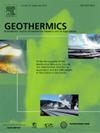Techno-economic evaluation of novel geothermal ground heat exchangers
IF 3.9
2区 工程技术
Q3 ENERGY & FUELS
引用次数: 0
Abstract
The present research introduces a new ground heat exchanger configuration, termed Reverse-T, aiming to reduce drilling and installation costs in ground-source heat pump systems while maintaining high thermal efficiency. To demonstrate its performance, we conducted three-dimensional numerical simulations of four different heat exchanger designs—U-type, radiator, spiral, and Reverse-T—under uniform technical and boundary conditions. The results show that the Reverse-T design can achieve an approximately 20% lower drilling cost than the spiral design and up to 88% lower cost than the U-type, with comparable thermal outputs of about 2000 W after 48 hours of continuous operation. In addition, a lifecycle cost analysis (LCCA) reveals that, despite a higher pressure drop (requiring a slightly larger pumping power), the Reverse-T configuration still delivers superior overall economic performance over the system’s operational lifetime. The Reverse-T requires the least investment. It is 20%, 88%, and 94% cheaper than the spiral, U-type, and radiator models, respectively. These findings highlight the potential of this innovative Reverse-T model in regions where drilling represents a major fraction of the total installation cost.
新型地热地下换热器的技术经济评价
目前的研究介绍了一种新的地面热交换器配置,称为Reverse-T,旨在降低地源热泵系统的钻井和安装成本,同时保持高热效率。为了证明它的性能,我们在均匀的技术和边界条件下对四种不同的换热器设计- u型,散热器,螺旋和反t型进行了三维数值模拟。结果表明,与螺旋设计相比,反t型设计的钻井成本降低了约20%,比u型设计的成本降低了88%,连续运行48小时后的可比热输出约为2000 W。此外,生命周期成本分析(LCCA)显示,尽管压力降更高(需要更大的泵送功率),但在系统的使用寿命内,逆t配置仍然具有出色的整体经济性能。逆t需要最少的投资。它比螺旋型、u型和散热器分别便宜20%、88%和94%。这些发现突出了这种创新的逆t模型在钻井占总安装成本大部分的地区的潜力。
本文章由计算机程序翻译,如有差异,请以英文原文为准。
求助全文
约1分钟内获得全文
求助全文
来源期刊

Geothermics
工程技术-地球科学综合
CiteScore
7.70
自引率
15.40%
发文量
237
审稿时长
4.5 months
期刊介绍:
Geothermics is an international journal devoted to the research and development of geothermal energy. The International Board of Editors of Geothermics, which comprises specialists in the various aspects of geothermal resources, exploration and development, guarantees the balanced, comprehensive view of scientific and technological developments in this promising energy field.
It promulgates the state of the art and science of geothermal energy, its exploration and exploitation through a regular exchange of information from all parts of the world. The journal publishes articles dealing with the theory, exploration techniques and all aspects of the utilization of geothermal resources. Geothermics serves as the scientific house, or exchange medium, through which the growing community of geothermal specialists can provide and receive information.
 求助内容:
求助内容: 应助结果提醒方式:
应助结果提醒方式:


